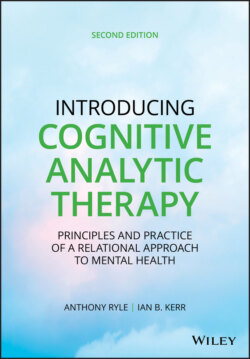Читать книгу Introducing Cognitive Analytic Therapy - Anthony Ryle - Страница 23
CAT Offers a General Theory, Not Just a New Package of Techniques
ОглавлениеThe book aims to describe and illustrate the methods, techniques, and tools developed in CAT and its underlying theory. While largely concerned with individual therapy, applications and uses in other modalities are considered, as are the wider implications for psychotherapy theory. While some CAT techniques could be incorporated in other treatment approaches (and vice versa), the model and the method involve much more than simply application of a range of disparate techniques. Psychotherapy patients can make use of a great many different psychotherapy techniques and there would be no point in simply offering a new combination of these under a new label. So why do we need theory?
One robust finding from psychotherapy research is that therapists employing some clear, credible theory generally do much better clinically (Castonguay & Beutler, 2006; Gabbard et al., 2005; Lambert, 2013; Roth & Fonagy, 1996). And in health care more generally, plausible, humane, and scientifically‐based theories are also much more likely to facilitate effective treatments, including those with a major psychosocial component. Another robust finding is that the patient's perception of the therapist as sympathetic and helpful is associated with a good outcome (Castonguay & Beutler, 2006; Gabbard et al., 2005; Greenberg, 1991; Lambert, 2013; Norcross, 2011; Roth & Fonagy, 1996; Wampold & Imel, 2015). In one important recent study, the strength of the therapeutic alliance in working psychologically with patients suffering from psychotic disorders was noted to be the key predictor of outcome, including prediction of adverse outcomes in association with a poor therapeutic alliance (Goldsmith, Lewis, Dunn, & Bentall, 2015). This being so, a major part of any therapy model must be concerned with how to achieve this and achieve a strong “therapeutic alliance,” given that the central problem for many patients is that they are often unwittingly damaging or disruptive in their personal relationships and, mostly for very good reasons, are mistrustful and possibly destructive of offers of help from others. Working successfully with these enactments is never easy but becomes increasingly important and difficult as more disturbed patients are considered. Being helpful means more than being nice, indeed it may frequently involve being very challenging. However, in CAT this would always be undertaken in a benign, non‐judgmental manner, even when clearly drawing attention to the unhelpful consequences or effects of problematic enactments on others, including on the therapist. This would be undertaken always with at least implicit reference to previously agreed reformulations (maps and letters). This also has the effect of depersonalizing and externalizing (or “defusing”) any problematic enactment beyond the immediacy of the therapy relationship and, hopefully, restoring a collaborative dialog. Such therapist “challenges” would be undertaken, therefore, in the context of, and contribute toward, a positive therapeutic alliance. This is aided in turn by working through and resolving such potential ruptures (“tear and repair” episodes) by means of the tools and the relational style of the therapy (see Chapters 2 and 8).
A crucial quality required, therefore, is to respect the patient enough to be honest. Techniques need to be understood in relation to the complex human issues that are at the heart of therapy. Those used in CAT, whether adapted from other approaches or specific to CAT, have, as their main aim, the development of the patient's capacities to know, reflect on, and ultimately control and replace unhelpful and distressing thoughts, actions, and experiences, and to benefit from the internalization of a benign, healing therapy experience. Other tools and techniques are designed to maintain the therapist's adherence to the methods and values of the approach (see Chapter 8). These provide a framework within which a sincere and often intense working relationship can flourish. Practice embedded in theoretical clarity must be combined with accurate empathy and compassion if therapists are to be able to reach and maintain an understanding of their patients' experiences and at the same time be fully aware of their own role in enabling and encouraging change. These may also assist in the inevitable dangers of collusion, whether with a patient in therapy, or with pressures imposed by the context of service provision. The latter may include, for example, pressures to get through waiting lists, avoid risks, or to achieve immediate, but frequently superficial, clinical “results.”
